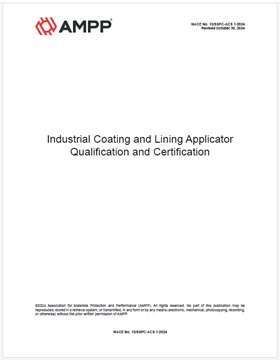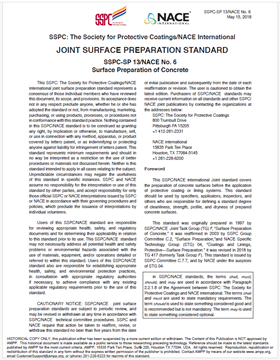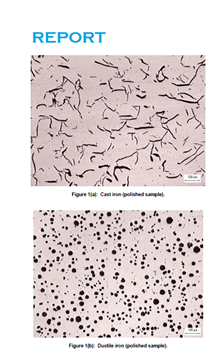Search
Coatings and Linings
View as
Sort by
Display
per page
NACE Emergency Guideline 2-HD1997 Protective Coatings for Carbon Steel and Austenitic Stainless Steel Surfaces Under Thermal Insulation and Cementitious Fireproofing
Product Number:
21079-HD1997
ISBN:
1-57590-037-8
Publication Date:
1997
$179.00
NACE No. 13/SSPC-ACS 1-2024, Industrial Coating and Lining Applicator Qualification and Certification
Product Number:
NACE No. 13/SSPC-ACS 1-2024
Publication Date:
2024
$109.00
NACE No. 2/SSPC-SP 10-HD1994-SG Near-White Metal Blast Cleaning-HD1994
Product Number:
21066-HD1994
Publication Date:
1994
$179.00
NACE No. 4/SSPC-SP 7-2006-SG (Spanish), Limpieza Abrasiva Superficial
Product Number:
21180-SG
ISBN:
1-57590-102-1
Publication Date:
2006
$179.00
NACE No. 6/SSPC-SP 13-2018, Surface Preparation of Concrete
Product Number:
21082-SG
Publication Date:
2018
$179.00
NACE Publication 01104-2004, Electrochemical Realkalization of Steel-Reinforced Concrete—A State-of-the-Art Report
Product Number:
24223-HD2004
ISBN:
01104
Publication Date:
2004
$179.00
NACE Publication 01104-2020, Electrochemical Realkalization of Steel-Reinforced Concrete—A State-of-the-Art Report
Product Number:
24223-SG
ISBN:
01104
Publication Date:
2020
$109.00
NACE Publication 02103-2003-SG, Liquid-Applied Coatings for High-Temperature Atmospheric Service
Product Number:
24219-SG
ISBN:
02103
Publication Date:
2002
$109.00
NACE Publication 10A292-2013-SG, "Corrosion and Corrosion Control for Buried Cast- and Ductile-Iron Pipe"
Product Number:
24250-SG
Publication Date:
2013
$109.00
NACE PUBLICATION 21414-SG (2016 Edition), “Maintenance Overcoating of Railcar Exteriors”
Product Number:
21414-SG
ISBN:
1-57590-363-6
Publication Date:
2016
$109.00
NACE Publication 21429-2018-SG - State of the Art Report on Corrosion-Resistant Reinforcement
Product Number:
21429-SG
Publication Date:
2018
$109.00
NACE Publication 41013-2013-SG, "State-of-the-Art Report: External Corrosion, Assessment and Control of Buried Piping Systems in Nuclear Power Plants"
Product Number:
24252-SG
Publication Date:
2013
$109.00












